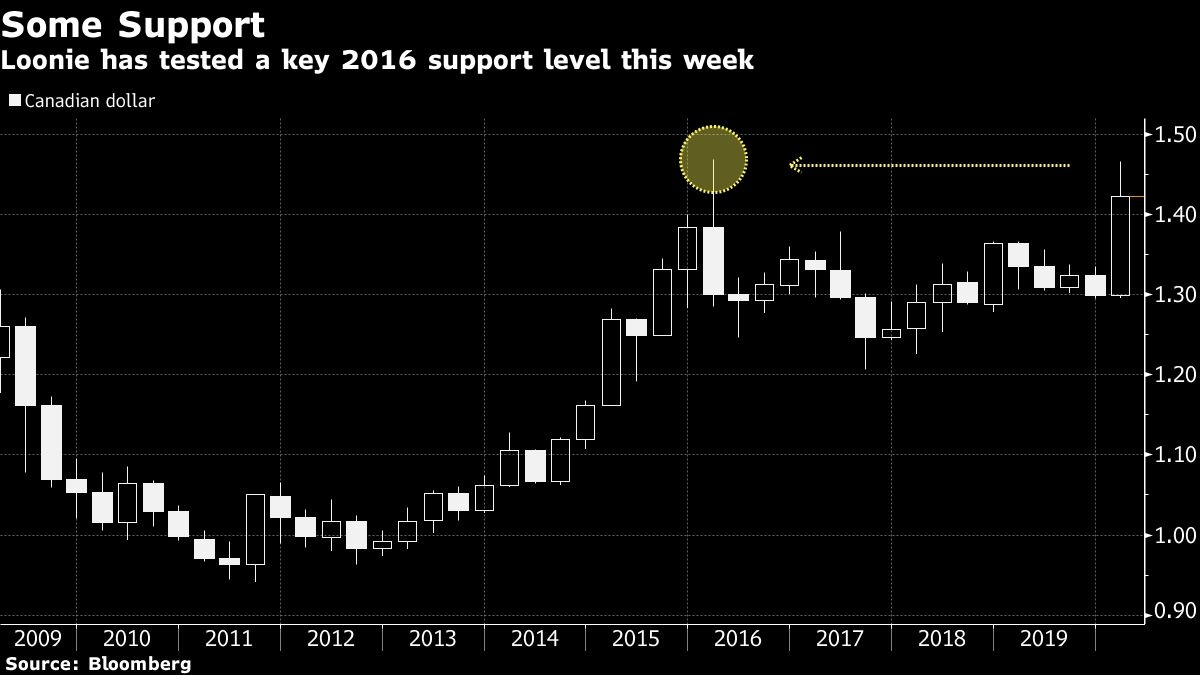Mar 20, 2020
Torn between oil and stimulus, loonie's fate hinges on 2016 low
, Bloomberg News
'The loonie is in more stable shape than you think': Chief Currency Analyst
The Canadian dollar has looked over the abyss and stepped back, pulled between an historic drop in oil prices and the possibility of an economic rebound later in the year.
The coronavirus pandemic, a collapse in Canadian crude to a record low and the rush to U.S. dollars sent the loonie tumbling; at one point this week, it was more than 10 down for the year.
While the currency has snapped back some of those losses after oil bounced Thursday, support is key around $1.455 per U.S. dollar, or 68.59 U.S. cents. That’s about where the loonie bottomed out in early 2016, the last time oil was tanking.
Still, the loonie is doing better than the British pound, Norwegian krone, Swedish krona and the currencies of Australia and New Zealand, which all have exposure to oil or natural resources.
One theory is that Canada’s economy might be able to bounce back quickly when the pandemic is under control, business resumes and borders reopen.
“Conditions could rebound quite aggressively in Canada,” said Simon Harvey, a London-based market analyst at Monex Europe Ltd. and Monex Canada Inc. “If they need to invest in government spending, they will. On top of that, the Bank of Canada has plenty of room to cut rates and stimulate the economy, the same can’t be said for other developed countries’ central banks.”

Prime Minister Justin Trudeau announced plans to roll out a fiscal package worth 3% of Canada’s economy as it grapples with fallout from Covid-19 outbreak. At a separate press conference, Finance Minister Bill Morneau called the government’s measures the “first phase” of the response and said the government is prepared to do more if needed.
The Bank of Canada’s benchmark overnight lending rate stands at 0.75 per cent, the highest in the Group of Seven, even after emergency cuts of a full percentage point in the past month.
“The Canadian economy is much more diversified than some of the other oil producers globally,” Bipan Rai, North American head of foreign exchange strategy at Canadian Imperial Bank of Commerce said by phone.
Harvey said the 2016 level remains a “big psychological support.” The currency tested that level on Wednesday and Thursday morning but it has so far hung in. The loonie was trading at $1.4275 per U.S. dollar on Friday morning. Oil has extended its huge rally from Thursday on President Donald Trump’s vow to get involved in the price war between Saudi Arabia and Russia.
Mazen Issa, senior FX strategist at TD Securities, sees grimmer times ahead with auto plant closures, the trade shock, depressed oil prices all hindering Canada’s growth. That, together with heavy consumer debt levels, will hit the nation’s economy from all sides and put further pressure on the loonie.
“We may see a bit more consolidation near that $1.45, $1.47 area but the reality is this is not an environment where the Canadian dollar will perform well and I don’t think there is any circumstance where markets are going to go long the Canadian dollar,” he said.
“If anything, the economy is probably in dire straits now more so than we’ve seen the past simply because the consumer is unable to bail the economy out,” Mazen added. “That $1.50 to $1.60 range, I think, shouldn’t be dismissed.”





